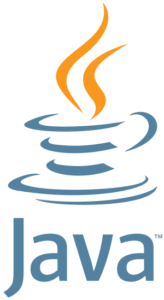What is Java?
Java is a general-purpose programming language, It is a high level, robust, secure and a pure object-oriented programming language. Java is also one of the cross-platform programming languages that allow programmers to write programs which can be used to run on any platform or computer architecture that supports a Java Virtual Machine (JVM).
Because of platform independence, It is an attractive solution for developing products that need to run on different operating systems like: (Windows, Mac, Unix), as developers do not need to write different versions for each platform.

Official Java logo
Source: Wikipedia
Who created Java?
The Java programming language was originally developed by a small team of engineers, known as the Green Team led by James Gosling at Sun Microsystems. The language was originally called OAK, at the time it was designed, Oak was not successful, later Sun Microsystems changed its name to Java and launched the first JDK (Java Development Kit) 1.0 version in 1995.
Java version history
- JDK 1.0 – January 1995
- JDK 1.1 – February 1997
- J2SE 1.2 – December 1998
- J2SE 1.3 – May 2000
- J2SE 1.4 – February 2002
- J2SE 5.0 – September 2005
- Java SE 6 – December 2006
- Java SE 7 – July 2011
- Java SE 8 (LTS) – March 2014
- Java SE 9 – September 2017
- Java SE 10 – March 2018
- Java SE 11 (LTS) – September 2018
- Java SE 12 – March 2019
Java Platforms / Editions
There are four major editions of Java available –
- Java SE (Standard edition)
- Java EE (Enterprise edition)
- Java ME (Micro Edition)
- JavaFX
Java SE (Standard edition)
Java SE is the most important and core edition. When people say the term “Java” they usually refer to this edition. This includes libraries and APIs that all Java programmers should learn (java.lang, java.io, java.math, java.net, java.util, etc.).
Java EE (Enterprise edition)
The Java Enterprise Edition (Java EE) is a collection of Oracle-owned Java APIs that software developers can use to write server-side applications. This platform is built on top of the Java SE platform. Therefore, Java SE must be installed. The Java EE platform allows developers to develop and run large-scale and secure network applications.
Java ME (Micro Edition)
The mobile edition of Java is called Java ME. Java ME is based on Java SE and is supported on most smartphones. The Java Mirco Edition comes with APIs and space-saving VM’s for running Java applications on small screen devices such as mobile phones, tablets, etc.
JavaFX
JavaFX is a software platform for creating and delivering rich internet applications that can be run on desktop devices as well as other various devices. JavaFX aims to replace Swing as a Java SE standard GUI library, but both will be included for the time being.